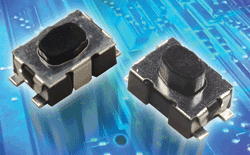Portability, criticality, and reliability are paramount concerns, with an eye toward health and safety regulations
BY JEROME SMOLINSKI
C&K Components, Newton, MA
http://www.ck-components.com
Over the years, the medical industry has evolved to include more self-care and at-home care, as well as highly technical (and often more expensive) equipment. The increased the demand for services outside of hospitals and healthcare offices is resulting in more portable equipment.
TAt the same time, the critical nature of medical equipment is as high as ever due to the intended use, and. aAs a result, the advancements toward self-care and the increasing performance demands for equipment in the medical field are driving many of the latest developments in switch components.
Portability
The rising cost of healthcare and insurance coverage has significantly affected how patients are receiving treatment in recent years. In-home care is becoming more common, and as a result, medical equipment must travel to homes as well, resulting in an increased demand for portable equipment.
Portable equipment must be smaller, lighter weight, and generally more transportable. Thus, the components that encompass the equipment must also follow suit.
Many medical devices use operation switches (on/off switches) and special function switches. Whereas miniature switches were previously suitable, medical equipment manufacturers are now requiring the use of ultraminiature and nanominiature switches to meet the increasing portability demands.
For example, portable blood pressure cuffs require ultraminiature switches not only for reduced size and weight, but also for ease of assembly. When transporting cuffs for field use, reduction in weight is paramount. By the same token, ease of assembly and operation increase the efficiency of the end device.
Criticality and reliability
Medical equipment manufacturers and purchasers are also making a greater investment in equipment. Coupled with the critical nature of the application and usage, component manufacturers must guarantee reliability of their devices. Design, materials, and plating all play a role in the maximum reliability of a switch.
Ultraminiature switches are being used in transdermal patches to dispense pain killers, antibiotics and other drugs through the skin. It is essential that switches in transdermal patch applications operate properly not only to ensure medication is being dispensed, but that the proper dosage is dispensed on schedule. To prevent accidental switch actuation and dispensing of the drug at an improper time, many designers are specifying high-reliability, self-regulating tactile switches.

Transdermal patches employ self-regulating tactile switches to trigger the dispensing of medicine.
Reliability issues are equally important in glucose meter applications. Detect switches used in glucose meters are responsible for initializing the process of analyzing the blood and therefore accurately reading the blood sugar level of a patient. This demands that the detect switch has an extremely high level of reliability to produce an accurate reading as well as a high life cycle count.
Depending on the nature of the application, even the smallest components used in medical field equipment are susceptible to contaminants and the effects of harsh environments, thereby affecting component reliability.
Nanominiature switches — some as small as 2.6 x 3.0 x 0.65 mm (0.45-mm body height, 0.20-mm actuator height and 0.13-mm travel) — are used in hearing aids, resulting in the need for component sealing to combat exposure to various types of moisture, including perspiration generated behind the ear.
Because sweat can be extremely abrasive, switches must be designed and manufactured to withstand these environmental elements. If not, moisture may enter the hearing aid and corrode the board, resulting in device failure. To prevent corrosion, devices and components can either be sealed or component plating materials can be altered.
As such, there is no room for error and critical situations offer little time to fix malfunctioning equipment. When sealing is not an option due to size or other considerations, switch manufacturers turn to alternate plating schemes to combat corrosion.
Increased health and safety regulations
Health and safety regulations placed on medical equipment, as well as customer specifications, must also be met, therefore affecting the design of the switch. For example, many components must be cleaned before being packaged to eliminate any surface germs. In some cases, switches used in transdermal patches are exposed to gamma rays when the end device is being cleaned. These gamma rays can potentially degrade some of the components within switches, particularly tact switches. This has driven switch manufacturers to develop specifically designed materials to ensure reliability when exposed to gamma rays. These types of constraints impact the overall design time of new medical device components, which can span two to three years.
Medical equipment manufacturers are also working toward the health and safety of patients by imposing their own specifications and reliability requirements through cleanliness, traceability, and overall design. There are continuing efforts to increase the quality level of components through such things as traceability, requiring component manufacturers to work within highly identifiable batches and specifically designed material flow processes. ■
Advertisement
Learn more about C&K Components





